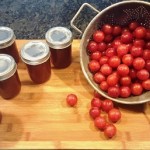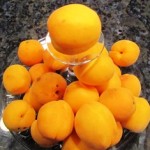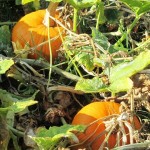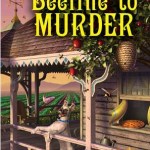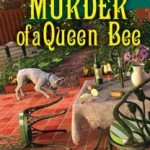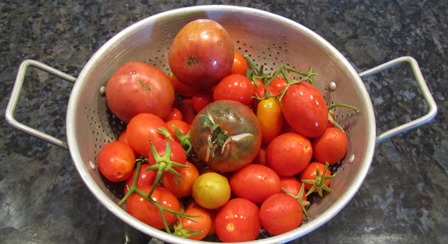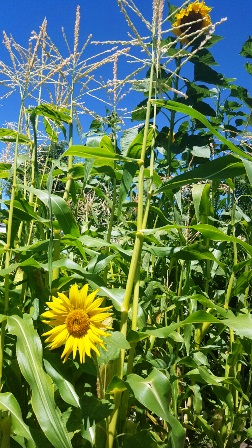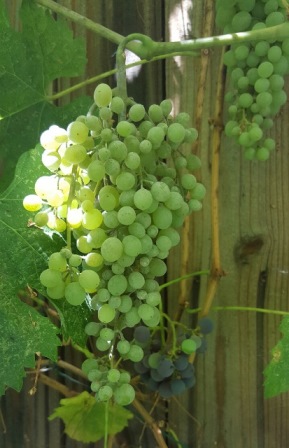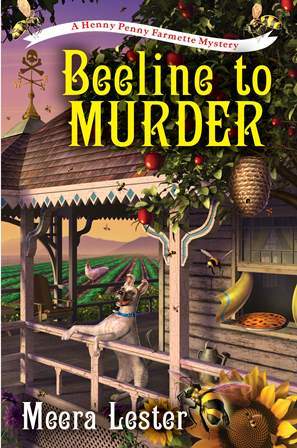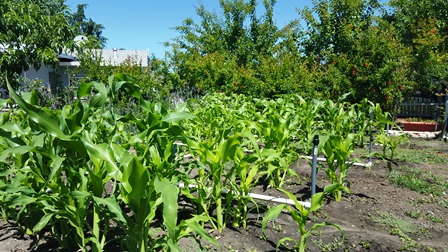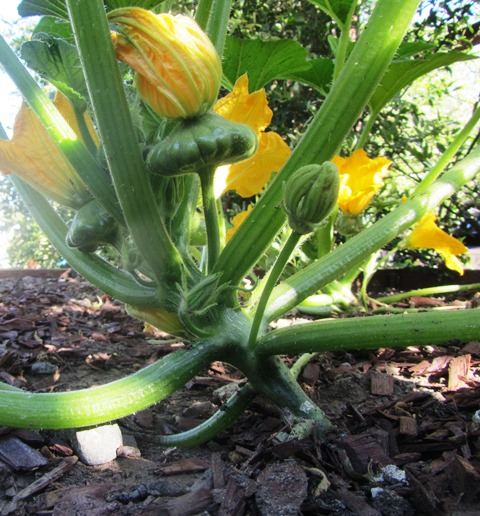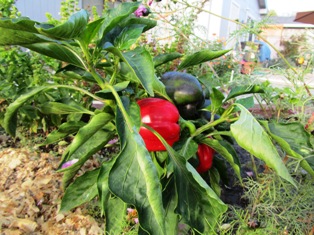Bless Others with Your Backyard Bounty
I called my neighbor just after sunup this morning and asked her to come help me pick plums. I have trees of ripe plums, three different varieties, as well as apricots that are ripening too fast for me to keep up with drying and jam-making.
She came laden with a dozen boxes. I had ladders and buckets and bowls ready. We were soon joined by her husband who also brought a ladder. We picked until the containers were full and still the trees held a ton of fruit.
He backed up their van and we loaded the fruit containers inside. They would drive the containers full of fruit to our local food pantry–the Contra Costa County Food Bank Warehouse at 4010 Nelson Avenue in Concord to distribute to needy families.
Saying thanks didn’t seem adequate enough, so I took my neighbors to my veggie patch to find some items just for them. I promised to deliver pumpkins when they were ready but for now we found heirloom zucchini, summer squash, and tomatoes.
Their gift of time and energy spent picking and packing fruit and delivering it to the food bank freed me up to start my jam-making. A friend once told me that what blesses one blesses others. It certainly proved true today.
If you’re interested in donating fresh food from your backyard garden, contact the Contra Costa Food Bank warehouse, located at 4010 Nelson Avenue, Concord, CA 94520 or call 925. 676.7543. Hours are Monday through Thursday: 7 a.m. to 7 p.m. Friday: 8 a.m. to 3 p.m. Saturday and Sunday: 8:00 a.m. to 3:30 p.m.
If you don’t have lovely, helpful neighbors who will assist you harvesting your bounty, contact gleaners in Contra Costa County at www.theurbanfarmers.org
_____________________________________________________________
If you enjoy reading this blog about my Henny Penny Farmette activities, check out my cozy mystery series (A BEELINE TO MURDER, MURDER OF A QUEEN BEE, and A HIVE OF HOMICIDES) as well as my current nonfiction books.
All are available online at Amazon, Barnes and Noble, and Walmart as well as traditional bookstores everywhere. The cozy mysteries are chocked full of delicious farmette recipes, tips of keeping honeybees and chickens, and farm trivia.
What’s Growing in the July Garden?
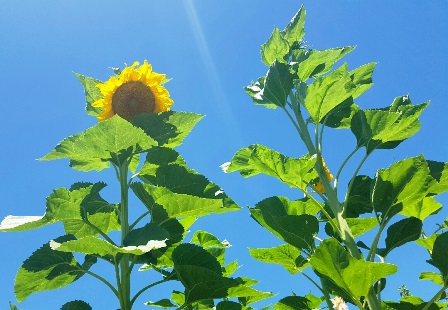
Sunflowers are native to North America and were taken to Europe in the 16th century; however, they date back to roughly 3,000 B.C. Honeybees love sunflowers.
Towering above the squash and lavender in my garden are rows of green corn stalks bearing ears of sweet, plump kernels. Snaking along the rows at the base of the cornstalks are vines laden with butternut squash and Armenian cucumber.
There are ripe tomatoes, too, especially the prolific heirloom–Red Beefsteak. I love cutting up some of these fresh, thin-skin tomatoes and combining them with basil, olive oil, grated cheese, and pine nuts as a topping for pasta. Add some grilled, seasoned chicken and you’ve got a quick and delicious summer lunch.
Zucchini and yellow squash sport large, showy blooms and are producing like crazy this month. While you can harvest and eat the blooms, we prefer the squash. Zucchini is delicious grilled or tossed with rosemary potatoes and onions or made into a French lentil and tomato salad (see recipe from last week’s posting).
Growing on vines trained over a wall and on supports, the green table grapes are beginning to swell. The taste is still a little tart, but will sweeten with the passage of another couple of weeks.
* * *
If you enjoy reading about farmette topics (including gardening, beekeeping, and delicious recipes), check out my cozy mysteries A BEELINE TO MURDER and also THE MURDER OF A QUEEN BEE in the Henny Penny Farmette series (from Kensington Publishing).
These novels are available through online retailers such as Amazon, Barnes & Noble, Kobo Books, and Walmart as well as from traditional bookstores everywhere.
Now available in mass market paperback, this debut novel launched the Henny Penny Farmette series of mysteries and sold out its first press run.
COMING SOON: The second cozy mystery in the Henny Penny Farmette series, available Sept. 29, 2016
Summer Salad with a Mediterranean Flair
Inspired by a salad made of lentilles du Puy that I recently ate at a Mediterranean restaurant, I decided to create my own version of it.
The salad combines tiny greenish/brown French lentils with seasonal fresh produce such as heirloom tomatoes and zucchini . I added a chopped onion (sauteed) and some hard-boiled eggs. Dried mint, crumbled fine, along with a little salt and pepper is the only seasoning you’ll need.
This salad is delicious served warm. But it is equally tasty served chilled on very hot days.
French Lentil, Zucchini, and Tomato Salad
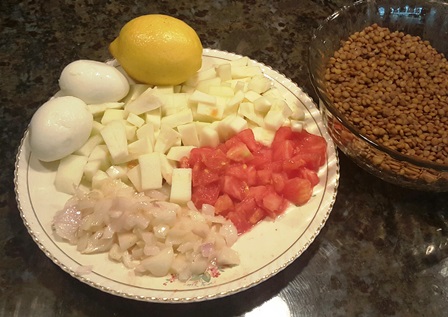
Ingredients for lentil salad include sauteed onions, heirloom tomato, zucchini, hard-boiled eggs, and fresh lemon juice
INGREDIENTS:
1 cup cooked French lentils (the small green or brown variety)
1/2 cup cooked Basmati rice
1 small firm tomato, skinned and chopped
1 cup peeled and chopped fresh zucchini
1 medium red or yellow onion, coarsely chopped and lightly sauteed
2 hard-boiled egg, chopped
1/4 c dried mint, crumbled fine by rubbing between your palms
1/2 medium juicy lemon
salt to taste
DIRECTIONS:
Combine the cooked lentils and rice. Add the zucchini, tomato, sauteed onion, and chopped hard-boiled egg to the lentil-rice mixture. Crumble the dried mint over the salad. Season with salt and pepper. Squeeze the juice from 1/2 lemon over the mixture and combine well before serving. Serves 4-6.
*Try pairing this salad with a rosemary chicken or lamb wrap for a light lunch.
* * *
If you enjoy reading about farmette topics (including gardening, beekeeping, and delicious recipes), check out my cozy mysteries A BEELINE TO MURDER and also THE MURDER OF A QUEEN BEE in the Henny Penny Farmette series (from Kensington Publishing).
These novels are available through online retailers such as Amazon, Barnes & Noble, Kobo Books, and Walmart as well as from traditional bookstores everywhere.
Now available in mass market paperback, this debut novel launched the Henny Penny Farmette series of mysteries and sold out its first press run.
The second cozy mystery in the Henny Penny Farmette series, available Sept. 29, 2016
Memorial Day Pleasures–A Good Book and Tasty Grilling
Memorial Day weekend marks the unofficial start to summer, which means time to grab a little reading pleasure and sample some locally grown produce to go with whatever you’re putting on the grill. And don’t forget dessert. My mind is already spinning with ideas.
Hanging out in the hammock calls for a book, so if you haven’t already snagged a copy of A BEELINE TO MURDER, get your e-book today through May 30 for a great price from KOBO Books. Here’s the link: https://store.kobobooks.com/en-us/ebook/a-beeline-to-murder.
For your grilling pleasure, choose some sweet corn to grill to go with the barbecue ribs or chicken. Here on the Henny Penny Farmette, our corn won’t be ready until July, so we’re going to pick some up locally grown corn at the farmers’ market in downtown Concord.
We’ve got more than a dozen heirloom tomato plants with fruit on them. Vine-ripened heirloom tomatoes for a cool Caprese salad are also available from the farmers’ market. And as I consider salads for our weekend meals, a red-skin potato with pesto and shredded basil leaves sounds almost as good as a conventional country style potato salad. But then again, I’d love a fresh broccoli-carrot salad with an Asian sesame-seed dressing or a simple cold slaw.
We’ve got plenty of zucchini and sweet snap peas in my garden that are ready to eat. These taste divine tossed into a garlic and butter shrimp pasta with a little shaved Parmesan cheese. Add a nice chardonnay or a traditional Cuban lime mojito along with some fresh baked bread and you’re ready to head for the table in the orchard.

Sunflower-design bundt pan makes this cake pretty enough to eat without the the caramelized pecan frosting.
Desserts are on my mind too–a simple cake or a plate of berries or watermelon rings my chime. But then again, with company, I could bake some linzer torte cookies with home-canned apricot jam. Or make a rhubarb-strawberry pie. The rhubarb stalks are cherry red and ready to cut.
These are some of my ideas of simple pleasures for Memorial Day to get you thinking about yours. Wishing you a peaceful, blessed Memorial Day weekend.
* * *
If you enjoy reading about keeping bees and chickens, raising heirloom vegetables and fruits, and other aspects of modern farmette life, check out my series of cozy mysteries from Kensington Publishing (New York).
A BEELINE TO MURDER, available in hardcover, will be released in paperback format in October. THE MURDER OF A QUEEN BEE will be released October 1, 2016. Find these titles on Amazon.com, BarnesandNoble.com, Walmart.com and other online bookstores and retailers as well as in traditional bookstores everywhere.
From Garden to Table, Easy-to-Grow Squash
I love summer squash, tossed into rosemary potatoes and served up with eggs and sausage on a Sunday morning; or, grilled with fish, or added to a freshly-made pasta sauce. Best of all, you can have it fresh, from your kitchen garden to your table, as squash is one of the easiest vegetables to grow. Squash is a super food, high in antioxidants, fiber, and Vitamin A.
Squash is one of the Three Sisters (corn and climbing beans being the other two), grown together as companion plants in the tradition of certain groups of Native Americans who planted these vegetables. A fourth sister might be the Cleome serrulata, the Rocky Mountain bee plant to attract pollinators for the beans and squash.
There is a scientific basis for growing these three together. The squash grows fairly large and spreads out, blocking weeds. The beans provide nitrogen to the soil. The corn shoots up a stalk that provides the support the beans need to climb. The three plants benefit each other.
Each year, I plant both summer squash and winter varieties such as butternut and pumpkin that have hard shells and store longer. All types of squash are easy to grow. They just need sun, water, and room. They aren’t fussy about soil.
Summer squash includes zucchini, yellow squash, and scalloped (or round) squash. Autumn/winter varieties require a longer growing period (up to 120 days) and include butternut, acorn, hubbard, and pumpkin.
Growing Tips:
Choose a well-drained, sunny spot in the garden for your squash.
Plant three seeds to a hill (roughly six inches apart).
When the squash are about a foot tall, thin to the healthiest seedling.
Water two to three times each week.
Harvest summer squash when still young; if left on the vine, the squash becomes tough.
Learning about GMO Food Safety
You might assume your zucchini and sweet corn is safe to eat but what if it was grown from GMO-treated seed, able to withstand an herbicide or even produce an insecticide as it grows? What happens in your gut when you eat that corn? What happens to animals fed such corn? These are questions that scientists, doctors, consumers, food safety advocates, and environmentalists all grapple with in their concern about GMO food safety.
The Non-GMO Project is a nonprofit organization concerned with GMOs and food safety. It explains on its Web site that a genetically modified organism (GMO) is a plant or animal that has been “genetically engineered with DNA from bacteria, viruses, or other plants and animals.” That means it is an anomaly in nature as such experimental combining of genes of different species does not occur in traditional crossbreeding or in nature (http://www.nongmoproject.org/learn-more).
Consumers might not be getting all the facts of what is known and what science is discovering about the health concerns of many Americans eating foods that contain GMOs. Estimates suggest that 80 percent of U.S. processed foods contain GMOs, meaning millions of Americans are eating foods that might not be all that safe to consume. Research into links between GMO consumption and ill health are ongoing but already GMO-altered foods, whether plants or animals, are raising health concerns.
Seed suppliers say that interest in non-GMO corn seed is growing among farmers because of lower costs, better animal health, and higher yields as well as increasing disenchantment with genetically modified traits of GMO seed (http://www.non-gmoreport.com/articles/january2013/Demand-growing-for-non-GMO-corn-seed.php)
With summer on the horizon, many people are planting seeds or seedlings in their gardens or are anticipating the plentiful vegetables available at produce stands and in supermarkets. But read the labels on all those mounds of squash, tomatoes, peppers, and potatoes.
Potatoes and tomatoes are considered low-risk for GMOs by the Non-GMO Project, that is, those two vegetables are not currently being genetically engineered. Although many people might think wheat is a concern, the Non-GMO Project states that wheat is not now nor ever has been genetically engineered, unlike soy, cotton, sugar beets, alfalfa, canola, zucchini, and summer squash.
More than 60 countries, including most of the developed nations, have banned or restricted GMOs. The United States is the exception, allowing production and sale of such products to continue. Consumers, scientists, and environmentalists opposed to genetic manipulation of plants and animals say avoidance and boycott of such products are consumer choices even as legal battles against bio-tech giants and anti-GMO advocates move through the courts.
As for summer corn, the best option might be to grow your own from heirloom seed that has not been genetically maniuplated. Otherwise, buy corn certified as non-GMO or from sources that support organic farmers and food sources such as Whole Foods and other organic markets. Check out the offerings for seed at Seeds Now (http://www.seedsnow.com/pages/shop-all-seeds).
 Facebook
Facebook Goodreads
Goodreads LinkedIn
LinkedIn Meera Lester
Meera Lester Twitter
Twitter





